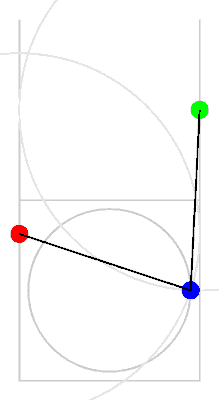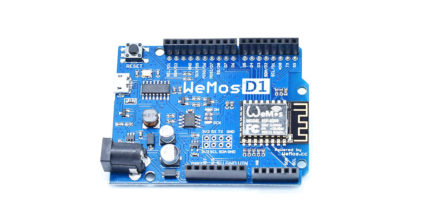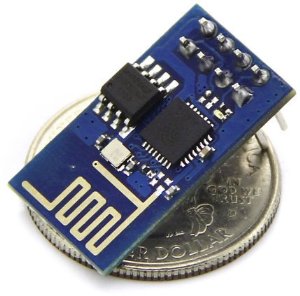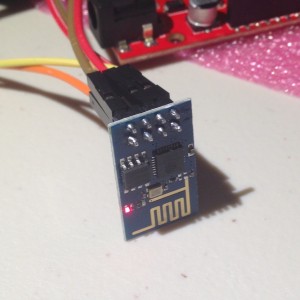I’m pretty old school when it comes to development. To me, writing code is something I like to do with vi (the editor that I learned three decades ago) and compile with Makefiles, especially for code that I do myself. In general, I prefer to do my development on either Linux or Mac OS too, so portable tools are my favorite. Increasingly, people have come to rely on complex development environments, many of which include code wizards that generate lots of the boiler plate needed to create applications, complex syntax coloring, and engines to refactor code. These environments are often significantly different from one another, are closed source, or rely on older versions of open source tools (like plugins for eclipse).
This seemed doubly true for this little Freescale development board that has been sitting unused since I purchased it at the last (or was it the one before that) Maker Faire. It is supposedly part of the “mbed” family of dev boards, which is supposed to make development across a variety of similar boards simple. But the reality is a dizzying array of odd products, including a web based IDE that just annoyed and confounded me. So, the board mostly sat unused. I did mention it in my “bucket o’ dev boards” video a couple weeks ago, and I thought “there must be a better way”.
Rather than toil away on my own, I tossed the question to my twitter followers:
Within minutes, @ukscone responded with this suggestion:
I had never heard of platformio, but I quickly read over the quickstart, and was impressed. Basically it’s a fairly simple utility called (appropriately enough) platformio, written in Python, and portable to Windows, Mac OS X and Linux. Compiled within it is knowledge of a large number of supported boards. You can get a list of supported boards by typing “platformio boards”, and you’ll get the output.
Platform: atmelavr
---------------------------------------------------------------------------
Type MCU Frequency Flash RAM Name
---------------------------------------------------------------------------
flora8 atmega32u4 8Mhz 28Kb 2Kb Adafruit Flora
trinket3 attiny85 8Mhz 8Kb 512B Adafruit Trinket 3V/8MHz
trinket5 attiny85 16Mhz 8Kb 512B Adafruit Trinket 5V/16MHz
btatmega168 atmega168 16Mhz 14Kb 1Kb Arduino BT ATmega168
btatmega328 atmega328p 16Mhz 28Kb 2Kb Arduino BT ATmega328
diecimilaatmega168 atmega168 16Mhz 14Kb 1Kb Arduino Duemilanove or Diecimila ATmega168
diecimilaatmega328 atmega328p 16Mhz 30Kb 2Kb Arduino Duemilanove or Diecimila ATmega328
esplora atmega32u4 16Mhz 28Kb 2Kb Arduino Esplora
ethernet atmega328p 16Mhz 31Kb 2Kb Arduino Ethernet
fio atmega328p 8Mhz 30Kb 2Kb Arduino Fio
leonardo atmega32u4 16Mhz 28Kb 2Kb Arduino Leonardo
megaADK atmega2560 16Mhz 248Kb 8Kb Arduino Mega ADK
megaatmega1280 atmega1280 16Mhz 124Kb 8Kb Arduino Mega or Mega 2560 ATmega1280
megaatmega2560 atmega2560 16Mhz 248Kb 8Kb Arduino Mega or Mega 2560 ATmega2560 (Mega 2560)
micro atmega32u4 16Mhz 28Kb 2Kb Arduino Micro
miniatmega168 atmega168 16Mhz 14Kb 1Kb Arduino Mini ATmega168
miniatmega328 atmega328p 16Mhz 28Kb 2Kb Arduino Mini ATmega328
atmegangatmega168 atmega168 16Mhz 14Kb 1Kb Arduino NG or older ATmega168
atmegangatmega8 atmega8 16Mhz 7Kb 1Kb Arduino NG or older ATmega8
nanoatmega168 atmega168 16Mhz 14Kb 1Kb Arduino Nano ATmega168
nanoatmega328 atmega328p 16Mhz 30Kb 2Kb Arduino Nano ATmega328
pro8MHzatmega168 atmega168 8Mhz 14Kb 1Kb Arduino Pro or Pro Mini ATmega168 (3.3V, 8 MHz)
pro16MHzatmega168 atmega168 16Mhz 14Kb 1Kb Arduino Pro or Pro Mini ATmega168 (5V, 16 MHz)
pro8MHzatmega328 atmega328p 8Mhz 30Kb 2Kb Arduino Pro or Pro Mini ATmega328 (3.3V, 8 MHz)
pro16MHzatmega328 atmega328p 16Mhz 30Kb 2Kb Arduino Pro or Pro Mini ATmega328 (5V, 16 MHz)
robotControl atmega32u4 16Mhz 28Kb 2Kb Arduino Robot Control
robotMotor atmega32u4 16Mhz 28Kb 2Kb Arduino Robot Motor
uno atmega328p 16Mhz 31Kb 2Kb Arduino Uno
yun atmega32u4 16Mhz 28Kb 2Kb Arduino Yun
digispark-tiny attiny85 16Mhz 5Kb 512B Digispark (Default - 16 MHz)
digispark-pro32 attiny167 16Mhz 14Kb 512B Digispark Pro (16 MHz) (32 byte buffer)
digispark-pro64 attiny167 16Mhz 14Kb 512B Digispark Pro (16 MHz) (64 byte buffer)
digispark-pro attiny167 16Mhz 14Kb 512B Digispark Pro (Default 16 MHz)
engduinov1 atmega32u4 8Mhz 28Kb 2Kb Engduino 1
engduinov2 atmega32u4 8Mhz 28Kb 2Kb Engduino 2
engduinov3 atmega32u4 8Mhz 28Kb 2Kb Engduino 3
lilypadatmega168 atmega168 8Mhz 14Kb 1Kb LilyPad Arduino ATmega168
lilypadatmega328 atmega328p 8Mhz 30Kb 2Kb LilyPad Arduino ATmega328
LilyPadUSB atmega32u4 8Mhz 28Kb 2Kb LilyPad Arduino USB
168pa16m atmega168p 16Mhz 15Kb 1Kb Microduino Core (Atmega168PA@16M,5V)
168pa8m atmega168p 8Mhz 15Kb 1Kb Microduino Core (Atmega168PA@8M,3.3V)
328p16m atmega328p 16Mhz 31Kb 2Kb Microduino Core (Atmega328P@16M,5V)
328p8m atmega328p 8Mhz 31Kb 2Kb Microduino Core (Atmega328P@8M,3.3V)
32u416m atmega32u4 16Mhz 28Kb 2Kb Microduino Core USB (ATmega32U4@16M,5V)
1284p16m atmega1284p 16Mhz 127Kb 16Kb Microduino Core+ (ATmega1284P@16M,5V)
1284p8m atmega1284p 8Mhz 127Kb 16Kb Microduino Core+ (ATmega1284P@8M,3.3V)
644pa16m atmega644p 16Mhz 63Kb 4Kb Microduino Core+ (Atmega644PA@16M,5V)
644pa8m atmega644p 8Mhz 63Kb 4Kb Microduino Core+ (Atmega644PA@8M,3.3V)
panStampAVR atmega328p 8Mhz 31Kb 2Kb PanStamp AVR
protrinket3ftdi atmega328p 16Mhz 28Kb 2Kb Pro Trinket 3V/12MHz (FTDI)
protrinket3 atmega328p 12Mhz 28Kb 2Kb Pro Trinket 3V/12MHz (USB)
protrinket5ftdi atmega328p 16Mhz 28Kb 2Kb Pro Trinket 5V/16MHz (USB)
protrinket5 atmega328p 16Mhz 28Kb 2Kb Pro Trinket 5V/16MHz (USB)
raspduino atmega328p 16Mhz 30Kb 2Kb Raspduino
Platform: atmelsam
---------------------------------------------------------------------------
Type MCU Frequency Flash RAM Name
---------------------------------------------------------------------------
due at91sam3x8e 84Mhz 512Kb 32Kb Arduino Due (Programming Port)
dueUSB at91sam3x8e 84Mhz 512Kb 32Kb Arduino Due (USB Native Port)
digix at91sam3x8e 84Mhz 512Kb 28Kb Digistump DigiX
sainSmartDue at91sam3x8e 84Mhz 512Kb 32Kb SainSmart Due (Programming Port)
sainSmartDueUSB at91sam3x8e 84Mhz 512Kb 32Kb SainSmart Due (USB Native Port)
Platform: freescalekinetis
---------------------------------------------------------------------------
Type MCU Frequency Flash RAM Name
---------------------------------------------------------------------------
IBMEthernetKit mk64fn1m0vll12 120Mhz 1024Kb 256Kb Ethernet IoT Starter Kit
frdm_k20d50m mk20dx128vlh5 48Mhz 128Kb 16Kb Freescale Kinetis FRDM-K20D50M
frdm_k22f mk22fn512vlh12 120Mhz 512Kb 128Kb Freescale Kinetis FRDM-K22F
frdm_k64f mk64fn1m0vll12 120Mhz 1024Kb 256Kb Freescale Kinetis FRDM-K64F
frdm_kl05z mkl05z32vfm4 48Mhz 32Kb 4Kb Freescale Kinetis FRDM-KL05Z
frdm_kl25z mkl25z128vlk4 48Mhz 128Kb 16Kb Freescale Kinetis FRDM-KL25Z
frdm_kl46z mkl46z256vll4 48Mhz 256Kb 32Kb Freescale Kinetis FRDM-KL46Z
Platform: nordicnrf51
---------------------------------------------------------------------------
Type MCU Frequency Flash RAM Name
---------------------------------------------------------------------------
wallBotBLE nrf51822 16Mhz 128Kb 16Kb JKSoft Wallbot BLE
nrf51_dk nrf51822 32Mhz 256Kb 32Kb Nordic nRF51-DK
nrf51_dongle nrf51822 32Mhz 256Kb 32Kb Nordic nRF51-Dongle
nrf51_mkit nrf51822 16Mhz 128Kb 16Kb Nordic nRF51822-mKIT
redBearLabBLENano nrf51822 16Mhz 256Kb 16Kb RedBearLab BLE Nano
redBearLab nrf51822 16Mhz 256Kb 16Kb RedBearLab nRF51822
seeedTinyBLE nrf51822 16Mhz 256Kb 16Kb Seeed Tiny BLE
hrm1017 nrf51822 16Mhz 256Kb 16Kb Switch Science mbed HRM1017
Platform: nxplpc
---------------------------------------------------------------------------
Type MCU Frequency Flash RAM Name
---------------------------------------------------------------------------
blueboard_lpc11u24 lpc11u24 48Mhz 32Kb 8Kb BlueBoard-LPC11U24
dipcortexm0 lpc11u24 50Mhz 32Kb 8Kb DipCortex M0
lpc11u35 lpc11u35 48Mhz 64Kb 10Kb EA LPC11U35 QuickStart Board
lpc4088_dm lpc4088 120Mhz 512Kb 96Kb EA LPC4088 Display Module
lpc4088 lpc4088 120Mhz 512Kb 96Kb EA LPC4088 QuickStart Board
lpc1549 lpc1549 72Mhz 256Kb 36Kb LPCXpresso1549
mbuino lpc11u24 48Mhz 32Kb 8Kb Outrageous Circuits mBuino
seeeduinoArchPro lpc1768 96Mhz 512Kb 32Kb Seeeduino-Arch-Pro
lpc11u35_501 lpc11u35 48Mhz 64Kb 10Kb TG-LPC11U35-501
lpc1114fn28 lpc1114fn28 48Mhz 32Kb 4Kb mbed LPC1114FN28
lpc11u24 lpc11u24 48Mhz 32Kb 8Kb mbed LPC11U24
lpc1768 lpc1768 96Mhz 512Kb 32Kb mbed LPC1768
ubloxc027 lpc1768 96Mhz 512Kb 32Kb u-blox C027
Platform: ststm32
---------------------------------------------------------------------------
Type MCU Frequency Flash RAM Name
---------------------------------------------------------------------------
disco_f334c8 stm32f334c8t6 72Mhz 64Kb 16Kb 32F3348DISCOVERY
disco_f401vc stm32f401vct6 84Mhz 256Kb 64Kb 32F401CDISCOVERY
disco_f429zi stm32f429zit6 180Mhz 2048Kb 256Kb 32F429IDISCOVERY
nucleo_f030r8 stm32f030r8t6 48Mhz 64Kb 8Kb ST Nucleo F030R8
nucleo_f070rb stm32f070rbt6 48Mhz 128Kb 16Kb ST Nucleo F070RB
nucleo_f072rb stm32f072rbt6 48Mhz 128Kb 16Kb ST Nucleo F072RB
nucleo_f091rc stm32f091rct6 48Mhz 256Kb 32Kb ST Nucleo F091RC
nucleo_f103rb stm32f103rbt6 72Mhz 128Kb 20Kb ST Nucleo F103RB
nucleo_f302r8 stm32f302r8t6 72Mhz 64Kb 16Kb ST Nucleo F302R8
nucleo_f303re stm32f303ret6 72Mhz 512Kb 64Kb ST Nucleo F303RE
nucleo_f334r8 stm32f334r8t6 72Mhz 64Kb 16Kb ST Nucleo F334R8
nucleo_f401re stm32f401ret6 84Mhz 512Kb 96Kb ST Nucleo F401RE
nucleo_f411re stm32f411ret6 100Mhz 512Kb 128Kb ST Nucleo F411RE
nucleo_l053r8 stm32l053r8t6 48Mhz 64Kb 8Kb ST Nucleo L053R8
nucleo_l152re stm32l152ret6 32Mhz 512Kb 80Kb ST Nucleo L152RE
disco_f051r8 stm32f051r8t6 48Mhz 64Kb 8Kb STM32F0DISCOVERY
disco_f303vc stm32f303vct6 72Mhz 256Kb 48Kb STM32F3DISCOVERY
disco_f407vg stm32f407vgt6 168Mhz 1024Kb 128Kb STM32F4DISCOVERY
disco_l152rb stm32l152rbt6 32Mhz 128Kb 16Kb STM32LDISCOVERY
disco_f100rb stm32f100rbt6 24Mhz 128Kb 8Kb STM32VLDISCOVERY
Platform: teensy
---------------------------------------------------------------------------
Type MCU Frequency Flash RAM Name
---------------------------------------------------------------------------
teensy20 atmega32u4 16Mhz 31Kb 2Kb Teensy 2.0
teensy30 mk20dx128 48Mhz 128Kb 16Kb Teensy 3.0
teensy31 mk20dx256 72Mhz 256Kb 64Kb Teensy 3.1
teensy20pp at90usb1286 16Mhz 127Kb 8Kb Teensy++ 2.0
Platform: timsp430
---------------------------------------------------------------------------
Type MCU Frequency Flash RAM Name
---------------------------------------------------------------------------
lpmsp430fr5739 msp430fr5739 16Mhz 15Kb 1Kb FraunchPad w/ msp430fr5739
lpmsp430f5529 msp430f5529 16Mhz 128Kb 1Kb LaunchPad w/ msp430f5529 (16MHz)
lpmsp430f5529_25 msp430f5529 25Mhz 128Kb 1Kb LaunchPad w/ msp430f5529 (25MHz)
lpmsp430fr5969 msp430fr5969 8Mhz 64Kb 1Kb LaunchPad w/ msp430fr5969
lpmsp430g2231 msp430g2231 1Mhz 2Kb 128B LaunchPad w/ msp430g2231 (1 MHz)
lpmsp430g2452 msp430g2452 16Mhz 8Kb 256B LaunchPad w/ msp430g2452 (16MHz)
lpmsp430g2553 msp430g2553 16Mhz 16Kb 512B LaunchPad w/ msp430g2553 (16MHz)
panStampNRG cc430f5137 12Mhz 31Kb 4Kb PanStamp NRG 1.1
Platform: titiva
---------------------------------------------------------------------------
Type MCU Frequency Flash RAM Name
---------------------------------------------------------------------------
lplm4f120h5qr lplm4f120h5qr 80Mhz 256Kb 32Kb LaunchPad (Stellaris) w/ lm4f120 (80MHz)
lptm4c1230c3pm lptm4c1230c3pm 80Mhz 256Kb 32Kb LaunchPad (Tiva C) w/ tm4c123 (80MHz)
lptm4c1294ncpdt lptm4c1294ncpdt 120Mhz 1024Kb 256Kb LaunchPad (Tiva C) w/ tm4c129 (120MHz)
That’s a LOT of different boards, including a large number of the ones I have. I was particularly interested in creating applications for the Freedom K64F board, which is supported. I typed “platformio install freescalekinetis”, and the script went out and found what version of tools it needed (gcc) and what support framework/libraries it needed, and installed them automatically (on Mac OSX/Linux, they end up hidden in the .platformio library in your home directory). You don’t need to go hunting around and find the right version, platformio takes care all of that (and can handle upgrades as new versions are created). In this way, platformio acts rather like a package manager such as apt-get on Linux.
To use platformio to build a new project, you create a directory, cd into it, and then run “platformio init –board=frdm_k64f”. This creates a src and lib directory, and a file called platformio.ini which describes which boards the project can support. It’s possible to create a single project which supports multiple boards (say, many different types of arduino) and build them all simultaneously, but in my case, I just used the one board. I then created this simple little program inside the src directory:
#include "mbed.h"
Serial pc(USBTX, USBRX);
Ticker timer;
DigitalOut led1(LED1);
DigitalOut led2(LED2);
DigitalOut led3(LED3);
int flip = 0 ;
int r=0, g=1, b=1 ;
void
attime()
{
int t = led1 ;
led1 = led2 ;
led2 = led3 ;
led3 = t ;
}
int
main()
{
pc.printf("\nHello world.\n") ;
led1 = r ;
led2 = g ;
led3 = b ;
timer.attach(&attime, 1);
for (;;) {
}
return 0 ;
}
This is a simple little program that prints “Hello world” back on the USB port, and then blinks the RGB LED in different colors. I didn’t really know much about the library support for these mbed based chips, but I’m old school. Snooping around in the .platformio directory, I found a bunch of header files that hinted at what is possible. I guessed on how this stuff worked, and coded the program up. You can then compile it with “platformio run”, or compile and upload it with “platformio run -t upload”. (There is a way to set it to automatically upload it if it compiles successfully too).
So, within one hour, I had this:
Awesome!
I’m looking forward to doing more experimentation with platformio, and now have it installed on both my Mac and Linux laptops. In addition to some of the odder platforms I have (like the FreeScale or STM32 boards) it also supports the Arduinos. I like the idea of being able to develop code for the Arduino without having to go through their IDE. I did a bit more experimentation with it last night, and got it to generate some display programs for the little OLED display that I wrote about earlier. Platformio also has a library manager which knows about a lot of the popular Arduino libraries, and can automatically download and update those. As I learn more, I’ll try to post more.
Thanks again to @ukscone! Best new thing I’ve discovered in weeks.




